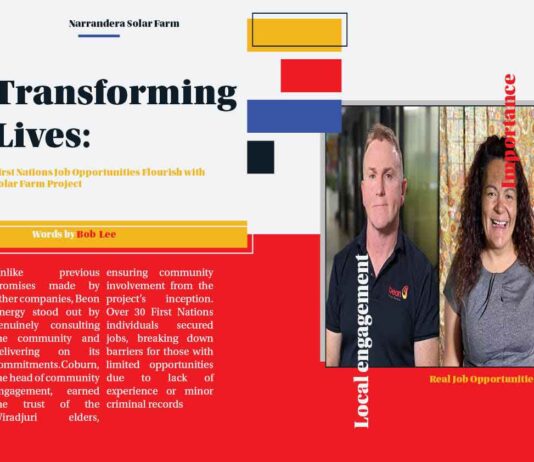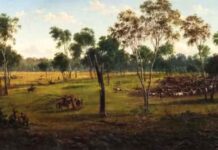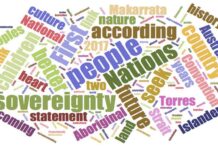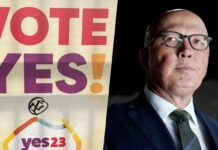Nine key lies told about the Voice to Parliament

“No” campaigners Kerrynne Liddle, Jacinta Nampijinpa Price, Nyunggai Warren Mundine and Michaelia Cash.
Two months ago, The Saturday Paper spoke with half a dozen senior “Yes” campaigners. Largely given anonymity, they were candid in their responses. With one exception, the members expressed severe frustration with the tone of the debate, with racist paranoia, with the vexatious repetition of certain questions, and with the mischief and malevolence seeded on social media. It was a game of Whac-A-Mole, they argued, ceaseless because bad faith is cheap.
There was anxiety alongside the frustration, an acute sense of the high stakes and the unrepeatability of this moment. Loss was unthinkable. There was also, collectively, a sense of hope and constructive urgency. Today there is greater despair, exhaustion and deeper anger – although to say so publicly would be self-defeating, contrary to the collective appearance of dignity and discipline to which “Yes” campaigners have committed.
While there have been sober and respectful critics of the Voice, there has also been an abundance of bad faith. A series of irksome claims has dominated front pages, governing news cycles for a few days and then evaporating, presumably having served their purpose. The sum, campaigners say, is not a coherent system of arguments but rather an exhausting, nerve-pinching squall of feedback. Voters, they fear, have simply tuned out the noise.
The following is a list, far from exhaustive, of some of the claims – made with varying degrees of sincerity or substance – that have helped define this frequently ugly campaign.
Claim: The Australian Electoral Commission will improperly confer advantage to the “Yes” campaign by accepting ticks on ballot papers, but discarding those marked with a cross.
Last month, Opposition Leader Peter Dutton made a rather silly, perhaps cynical, intervention in the debate when he argued on Radio 2GB that: “If a tick counts for ‘Yes’, then a cross should count for ‘No’. I just think it just stinks to be honest … It’s as clear as that. Otherwise, it gives a very, very strong advantage to the ‘Yes’ case … It just seems to me that they’re taking the opportunity to skew this in favour of the ‘Yes’ vote when Australians just want a fair election, not a dodgy one.”
Dutton’s interviewer, Ben Fordham, furiously agreed. Dutton promised he would write to the electoral commission asking it to review its practices. For a few days, it became a major story.
There are a few things to unpick here. The first is that the ballot paper will clearly instruct voters – twice, in fact – to record their preference with the words “YES” or “NO”. The use of words rather than symbols to declare your preference on referendum ballots dates to the 1960s, which even then was a resumption of a practice used up until 1926.
Second is the likely tiny numbers of ballot papers that would be deemed informal by the AEC because of the use of crosses. In the most recent federal referendum, in 1999, in which there were two separate questions and thus two separate ballot papers, the percentage of informal votes was less than 1 per cent. Given there are multiple reasons for ruling a ballot paper informal – for example, that it is left blank – we might presume that the proportion of ballot papers rendered informal by crosses is even smaller.
Third, the AEC operates under referendum legislation, in existence for more than a century. Part of that legislation is what’s called a “savings provision” – that is, allowing the AEC to count certain ballot papers that have ignored the instructions but that nonetheless clearly convey the voter’s intention. This was enacted in a generous spirit to limit accidentally informal votes.
On the matter of interpreting ticks and crosses, the AEC received legal advice in 1988, reinforced this year, that ticks can be read unambiguously as agreement with the proposition, while crosses retain an ambiguity. Earlier this month, Clive Palmer and Ralph Babet, of the United Australia Party, made a bid in the Federal Court to force the AEC to count crosses as a “No”. The case was heard this week, when an unimpressed Justice Steven Rares dismissed it, ruling a cross was “inherently ambiguous”. The AEC’s “longstanding legal advice” had been upheld in court.
All of which seems like common sense if you consider that various forms – from banks, hospitals, etc – may ask applicants to mark certain boxes with an X. If this matter of ticks and crosses – again, a practice decades-old – was so disturbing to Dutton and his caucus, then there have been several occasions to raise it: in parliamentary debate, for instance, or by lodging concerns with the Joint Standing Committee on Electoral Matters, which only earlier this year conducted an inquiry into the referendum. But it was never raised. Not once.
It’s specious stuff, though it should not be dismissed as trivial: by casting aspersions on the integrity of the AEC, Dutton added another drop of poison to the well of the public’s faith in its democratic institutions. “If there’s less confidence in our institutions,” one senior “Yes” campaigner told The Saturday Paper, “you’re less willing to take a leap of faith.”
If this matter of ticks and crosses … was so disturbing to Dutton and his caucus, then there have been several occasions to raise it: in parliamentary debate, for instance, or by lodging concerns with the Joint Standing Committee on Electoral Matters … But it was never raised. Not once.
Claim: The Uluru Statement from the Heart is not one page but secretly 26 pages.
In August, Sky News’s Peta Credlin declared her scoop: using freedom of information laws, she had “forced” from the government the full Uluru Statement from the Heart, which was not, as its authors claimed, a pithy one-pager. Rather, she said, it was a vastly longer and more ambitious statement that had been “hidden” from the public.
Here, again, was the theme of sinister concealment: that the “Yes” campaigners were deceptive, that the Voice was a Trojan Horse from which a revolutionary occupation of executive government would commence.
This was false. What was “hidden” were explanatory notes and the minutes of meetings, which had been published online years ago. In fact, one of the statement’s authors, Professor Megan Davis, had long encouraged people to read this extra material.
In a statement, the National Indigenous Australians Agency described the supposedly secret 26 pages of documentation as “The one-page Uluru Statement from the Heart, followed by 25 pages of background information and excerpts of regional dialogues that informed the one-page Uluru Statement from the Heart.”
There was a bitter irony here, not lost on Davis: the material she had encouraged the public to read was now being interpreted as a sinister secret.
Claims: The Voice would weigh in on everything from interest rates to defence spending. And, the Voice would mean every government decision could be taken to the High Court.
The Australian parliament has proposed a new chapter be included in the Constitution, part two of which proposes that “the Aboriginal and Torres Strait Islander Voice may make representations to the Parliament and the Executive Government of the Commonwealth on matters relating to Aboriginal and Torres Strait Islander peoples”.
The inclusion of “Executive Government” in the proposal, as opposed to merely “parliament”, was worryingly capacious for Professor Greg Craven, a constitutional lawyer and member of the Constitutional Expert Group, who has argued that, properly defined, “Executive Government” means everyone employed in the federal public service – from the prime minister all the way down to the “lighthouse keeper’s bulb polisher”.
Another concern was with defining “listening” – government may hear the representations of the Voice, but what would that oblige, exactly? Enactment of all advice? Or merely receiving it? And, given its constitutional enshrinement, how might the Voice lodge its grievances? Would there be appeals to the High Court? And would that be a problem anyway? Might the acquittal of executive power be confused, or slowed by this theoretical litigation?
They are serious questions, but ultimately the Constitutional Expert Group determined, in its final advice from March this year, that “the proposed amendment would not give rise to any legal obligation on the Parliament or the Executive to give effect to representations of the Voice and could not result in the invalidation of legislation”.
It qualified this, however, saying: “There were differing views among the Expert Group as to whether the proposed amendment is likely to be interpreted by a court as giving rise to a constitutional obligation for government decision-makers to consider relevant representations by the Voice, even if Parliament did not require this … If it were desired, there are a number of ways in which the draft constitutional provision could be amended to make it clear that Parliament could legislate about the legal effect of Voice representations to the Executive Government, leaving this a matter for democratic control by Parliament.”
In April this year, the solicitor-general, Stephen Donaghue, released his opinion of the Voice, saying it would “enhance” the responsiveness and responsibility of our government and “will not fetter or impede it”.
Greg Craven was heartened by this and remains “100 per cent committed” to enshrining the Voice in the Constitution.
Claim: The referendum will actually contain two questions.
This is patently false. It is part of a larger string of lies spread about the Voice, especially on social media. There are the “formal” arguments of the “No” campaign, prosecuted publicly, and then there is the shadow campaign conducted by bad actors online.
The provenance of the following is unknown, but it has recently, and excitedly, been propagated on Facebook, and is just one example of disinformation to be seeded this year. The message reads:
“BE AWARE. The Government has actually set up a ‘Trick’ in the Referendum to come for ‘The Voice’. SO – If you tick yes to the question of ‘do you recognise the indigenous people?’ This tick will override your NO vote for the other question. Tick NO to both questions. Also do it in PEN and NOT with the pencil they will provide you with. Dangerous times ahead folks.”
While garbled, wilfully confusing and conspicuously silent on just what, exactly, this fictitious second question is, the note’s tone is appealingly ominous for those inclined to believe the Voice is part of a grander conspiracy to enforce reparations, the forced acquisition of backyards or, grander still, that it forms one part of the World Economic Forum’s bid for a global government – all theories that can be found online.
“The Voice … is actually coming from members of the communist movement in Australia,” former MP George Christensen told ADH TV last month. “It will be a communist’s picnic … They want to spear the Australian nation in the thigh as penalty for our past, apparent wrongdoings.”
The referendum debate has demonstrated how easily made and swiftly spread disinformation can be. To be clear, October 14’s referendum will ask voters just one question. A sample copy of the ballot paper can be found on the AEC’s website.
Claim: The Voice will simply fatten bureaucrats.
It’s worth repeating that the conception of the Voice came from First Australians, who asked, in the Uluru Statement from the Heart, for “substantive constitutional change and structural reform” and not merely symbolic recognition. “For an act of recognition to be effective, it must be expressed in terms agreeable to those who are to be recognised,” wrote Tim Rowse, the emeritus professorial fellow in the Institute for Culture and Society at Western Sydney University, this year. “To recognise someone in terms they find repugnant or trivial is to misrecognise them, making the relationship worse rather than better.”
While the opinions of First Australians are not joined monolithically, the Uluru statement was the result of a historically exhaustive consultation. It was a consensus position, as best as can be obtained. More to the point, the Voice, if successful, would be comprised of First Australians. Finally, the stated purpose of the Voice is not to add to layers of bureaucracy, but to better advise the system that already exists and has failed to close the gap.
Claim: The Voice will “get rid of the parliament that’s there now and will end up taking over”.
These words come from the mouth of Kerry White, a board member of Nyunggai Warren Mundine’s “No” campaign group Recognise a Better Way. They were made on a podcast released in December.
Claim: The Voice will “get rid of the parliament that’s there now and will end up taking over”.
These words come from the mouth of Kerry White, a board member of Nyunggai Warren Mundine’s “No” campaign group Recognise a Better Way. They were made on a podcast released in December.
Claim: There is insufficient detail about the Voice.
In July 2022, speaking from the Garma Festival, the newly elected prime minister, Anthony Albanese, was interviewed by the ABC’s David Speers for the Insiders program. “One of the things I’m trying to avoid here,” Albanese said about the Voice, is “people looking for all of the detail and saying, ‘Well, if you disagree with these 50 clauses, if you disagree with one out of the 50 but 49 are okay, vote “No” ’. We’re not doing that. We’re not doing that. We’re learning from history.”
The history that Albanese was referring to was the failed referendum of 1999 – remembered principally as the proposal to transform Australia into a republic, but which also asked Australians about the inclusion of a constitutional preamble.
The conventional wisdom about why that referendum failed is that too much detail was proposed regarding the model. The question did not merely propose a republic but specified that parliament would appoint the head of state. This was a compromised model for some republicans, who desired that person to be directly elected, and so they voted “No”. “By drawing the analogy with 1999, Albanese was deliberately overriding the advice of [former chief justice] Murray Gleeson, who’d been on the referendum council in 2019, when he said the punters won’t vote for it unless they see it first,” Father Frank Brennan tells The Saturday Paper. Brennan is a Jesuit priest, human rights lawyer and prominent Voice advocate. “Whoever was advising him decided not to run with the three-step process, which had been spelt out eloquently by Noel Pearson in an address on St Patrick’s Day in 2021: first, that we need to design the Voice; second, and there’s another analogy here, which is the same-sex marriage debate, provide an exposure draft bill so everyone knows what they’ll be voting on; and thirdly, settle the terms of the wording. That made a lot of sense, but then Albanese was elected and he abandoned that. Now, that said, I have some sympathy for Albo here because he had three successive Liberal PMs before him saying no to this. But given the history of referendums – that few succeed – more should have been done. But neither side was interested. They’d dug themselves in their respective holes. From there, there was no prospect of reasonable dialogue.”
This gave Dutton, and other “No” campaigners, their principle, arguably most persuasive, argument: that voters were being asked to enshrine something, the details of which – the Voice’s composition, function and powers – were undefined.
However, as a former adviser to Albanese mused to The Saturday Paper this week, the prime minister was probably damned either way – by the absence of detail or, in the alternative universe, by its abundance. The decision was made that the functions of the Voice – the detail – would be legislated by parliament once a referendum had enshrined support for its existence.
When the official pamphlets on the referendum were issued to voters – one written by each camp – the “No” polemic was distinctive for its relentless negativity. It conceded very little – about either the proposition, or history – and said even less about what it might propose instead.
The pamphlet and the lobbying around it, official and unofficial, is part of the strange, ceaseless, sometimes tactical pollution of this campaign, described to The Saturday Paper by several senior “Yes” campaigners as nauseating. “There’s enormous negativity and hysteria,” says one. “Thousands of dollars are being spent every day on misinformation on social media. It’s a shitshow, but negativity sells.”
Father Brennan says that things could have been different, and that now “I lament that our national leaders have been playing roulette with the country’s soul. The debate should have been much better.”
This article was first published in the print edition of The Saturday Paper on September 23, 2023 as “Fact check: Nine key lies told about the Voice to Parliament”.










